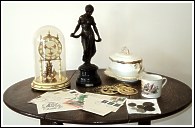
Punters and Collectors

Out of date can mean big money!
You may have seen one of those antiques programmes when people bring their old furniture and ornaments to have them dated and valued; or the quiz shows featuring informed individuals discussing the merits and possible prices of selected items. They are entertainment for anyone interested in the subject and can also excite the imagination of ordinary folk - doesn't that brass coal scuttle look like the one Grandma had? I'm sure we didn't throw it out. Then off they go, rummaging in the attic or the basement where they may find not only the thing they are looking for, but are likely to uncover possible valuables among the junk. Specialists actually make a living by buying and selling collectables: anything from china cabinets to butter dishes. Then there are the punters. As long as there are collectors, there will be opportunists around who think they can cash in on a ready and gullible market. Anyone who fancies being one of the latter, however, might want to give it some serious thought first.
The bottom line is: no matter what the experts may say, a piece is only worth as much as someone is prepared to pay for it. Another mistake amateurs often make is to try bringing an article back to its original glorious state. Antique furniture is a good example. Restoration by a professional is expensive, and after the job has been done, the owner might expect the value to have increased. In most cases, the reverse is true. Had it been left as it was, damaged or not, it would have fetched considerably more. Short of ready cash, my Grandfather decided to sell some bits and pieces including the upright piano. The buyer offered him a good price for the lot, but only because of the piano stool. Although riddled with wood-worm it was, he said, worth more than the rest put together. Certainly, one man's junk can be another's treasure; conversely, buying what seems a good profit-maker based on looks and price is a trap if you know very little about the market.
Research can help to a degree. At least knowing the basics about valuing collectables is a start. Depending where it is acquired, however, this information can be as dated as the items being researched. Anyone hoping to turn a profit needs to find out about current trends. What may have been in vogue for decades can rapidly become passé, leaving the prospective seller hard pushed to break even. On-line searches make life easier, but there's no substitute for the real thing. Especially when buying, it is advisable to see the goods in the flesh, so to speak; and before picking up that bargain from a private seller, it might be a good idea to check around the appropriate shops for something similar that will be a guide to price based on condition. Just keep in mind that dealers are into making money, sometimes by doing business with other dealers, so they'll always be thinking about the sell-on profit. Even when you trust one to be absolutely straight, make the effort to visit a few more for comparisons.
Stamps
Most of us had a stamp collection when we were kids. The inclusions were usually steamed or soaked off letters. Sometimes extras, especially foreign ones, were purchased from shops or mail order companies. We stuck them in albums, often carelessly, not realising that one or more might be sought-after and worth much more than their face value. We are wiser now, but not nearly as informed as we need to be if stamps-for-profit is our goal. Essentially, old is good as long as the item is undamaged. Unused with no postmark and the glue still on the back is a bonus if, of course, anyone is interested. Apparently, US stamps printed in the last 70 years are worth nothing except for postage - I'm told they are still legally useable. First Day Covers, they being stamps post-marked on the first day of issue, may be worth something, but much depends on the integrity of the buyer, and the envelope - with an address it is worth less than one that is left blank. For detailed information on collecting and valuing stamps consult: the Scott Postage Stamp Catalogue (USA); and the Stanley Gibbons Commonwealth and British Empire Stamps Catalogue.
Coins
I have an old tobacco tin containing coins my Dad saved. Some are Victorian, quite a few apparently minted from solid silver; I doubt they are worth any more than the value of the metal they were made from, because they are all worn or damaged. Coins need to be in very good condition, excellent in fact, before a buyer will take interest. Certain ones are in demand, but usually they won't be considered unless in mint condition, meaning exactly that - straight from the mint, unused and unadulterated. Polishing dull ones up with metal cleaner just makes them shine, but it won't impress a knowledgeable numismatist. In fact, the grading of coins is very specific, differing considerably depending on a country's standard. This can mean that a coin won't pass muster in the UK, whereas it might sneak through in the US. Check with The American Numismatic Association to learn more about grading coins.
See next page for Part 2 of Punters and Collectors
Click this ![]() image to view or print complete article.
image to view or print complete article.
Home Display Money Health Focus HandyHints Popcorn Recipes eBooks About Contact
copyright © 2014-2015 All Rights Reserved